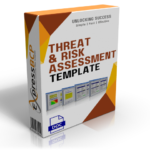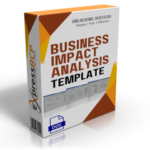Business disruptions are inevitable. Whether it’s a cyberattack, natural disaster, or supply chain breakdown, it’s not a matter of if something will go wrong, but when. In fact, 25% of businesses never recover after a major disaster (Source: FEMA).
That’s a staggering number, right? But here’s the thing: with a solid business continuity plan (BCP), you don’t have to be part of that statistic.
If you’re new to Business Continuity planning, don’t worry. You’re not alone.
Creating a plan from scratch can feel like trying to map out a route through unfamiliar territory. But what if you had a tool that could not only speed up the process but also help you think of scenarios you might miss? That’s where using ChatGPT to enhance your business continuity planning comes in.
In this blog, I’ll show you exactly how to use it to improve your BC program—faster, smarter, and with fewer headaches.
Ready to dive in? Let’s make your business continuity plan airtight!
Why Use ChatGPT for Business Continuity Planning?
ChatGPT isn’t just another tech trend—it’s a practical tool that can genuinely make your life easier, especially if you’re just getting started with business continuity. Think of it as your personal assistant, ready to help you brainstorm, write, and refine your BC plan. It’s like having an expert on hand 24/7, without the consultant fees.
Whether you’re developing your first BCP or fine-tuning your incident response strategies, ChatGPT can jumpstart your efforts.
How? By speeding up content creation, helping you identify potential risks, and ensuring that nothing crucial slips through the cracks. No fluff—just actionable insights that help you get the job done.
Let’s look at specific ways ChatGPT can support your business continuity planning.
Helpful ChatGPT Prompts for Business Continuity Planning
Here are ChatGPT prompts that dive deeper into each stage of your business continuity planning. These prompts will guide you through creating more comprehensive and detailed components of your BC program, making it easier to cover all your bases.
- Creating a Business Continuity Strategy
You need a strategy before you start crafting your plan. A good strategy will outline the key areas of your business that must remain operational during a disruption. Use ChatGPT to generate a strategy framework tailored to your specific needs.
Prompt Example:
“Create a detailed business continuity strategy for a small manufacturing company that relies heavily on just-in-time supply chain processes and cloud-based software for operations. Focus on ensuring operational resilience in the event of supply chain disruptions, prolonged power outages, and cybersecurity incidents. Provide recommendations for how to handle each disruption and outline which departments should be responsible for each component of the strategy.”
This will give you a specific roadmap, outlining not only the threats but also clear steps on who’s responsible and how each scenario will be handled.
Check out our Business Continuity Plan Template to put your strategy into action and structure your plan efficiently.
- Risk Assessment and Business Impact Analysis (BIA)
Risk assessment is about identifying potential threats to your business, and a Business Impact Analysis (BIA) helps you understand the consequences of those risks. ChatGPT can help you develop a detailed assessment of both.
Risk Assessment Prompt Example:
“Provide a detailed risk assessment for a mid-sized financial services company. List at least 10 potential internal and external risks, including operational, cyber, regulatory, and physical risks. For each risk, estimate the likelihood, potential financial impact, and the operational areas that would be most affected. Afterward, suggest mitigation strategies for each risk and identify which departments would be responsible for implementing them.”
Business Impact Analysis Prompt Example:
“Guide me through conducting a detailed business impact analysis (BIA) for a retail company with both physical and online stores. Include the specific data points I should gather, such as revenue loss per hour, impact on customer service, and effect on supply chain processes. Provide a sample outline for the BIA report, breaking down key sections like critical processes, potential downtime, and resource dependencies.”
These prompts will help you think comprehensively about risks and their consequences. Pair this with the Business Impact Analysis Guide for even more in-depth insights.
- Writing Crisis Communication Plans
Crisis communication requires clarity, speed, and a calm tone. It’s essential to prepare messages ahead of time that can be quickly adapted during a disruption. ChatGPT can help draft precise, clear communication for a variety of situations.
Prompt Example:
“Draft a comprehensive crisis communication plan for a company experiencing a cybersecurity breach that affects customer data. The plan should include an internal communication outline for employees, a public statement to be released to customers, and talking points for press inquiries. Each communication should detail the actions the company is taking, timelines for resolution, and any instructions for the audience (e.g., steps customers need to take to protect their information).”
You can tweak these drafts to fit your company’s tone of voice and situation. Our Business Continuity Plan Template includes Crisis Communication and this prompt can help you put the final touches on these essential messages.
- Testing and Exercising Your BC Plan
A business continuity plan isn’t effective until it’s tested. Running exercises and simulations is key to ensuring your plan works when it’s needed most. Use ChatGPT to create detailed testing scenarios.
Prompt Example:
“Create a realistic tabletop exercise scenario for a large e-commerce company where the primary data center experiences a power failure, resulting in a 12-hour outage of the company’s website and online ordering system. Include prompts for each phase of the exercise, such as initial discovery, escalation to IT teams, customer notification, and system recovery. Provide questions for participants to answer during the debrief session, such as, ‘What worked well?’ and ‘Where were communication gaps?’ Offer recommendations for improving future response times.”
This prompt not only gives you a scenario but also helps you guide your team through every phase of the exercise. Use our Tabletop Walkthrough Exercise Template to organize and document the results of your tests.
- Reviewing and Updating Your Plan
A business continuity plan isn’t static—it needs to be reviewed and updated regularly to stay relevant. Use ChatGPT to guide you through an in-depth review of your plan.
Prompt Example:
“Walk me through a detailed process for reviewing and updating a business continuity plan after a major organizational change, such as the acquisition of another company. Outline which sections of the plan should be updated first (e.g., new critical business processes, updated contact lists, and altered supply chain dependencies). Provide a checklist for ensuring that every necessary section of the plan is reviewed, including risk assessments, BIA, and communication protocols.”
With this detailed checklist in hand, you can ensure your plan stays current and ready for any situation. Don’t forget to keep your documents organized with our Business Continuity Plan Template to make future updates easier.
Bringing It All Together
ChatGPT is more than a writing tool—it’s a practical ally in your business continuity journey. By using these enhanced prompts, you’ll be able to cover every angle of your business continuity plan, ensuring it’s comprehensive, clear, and effective. Whether you’re identifying risks, drafting communication plans, or running test scenarios, ChatGPT can help streamline your process.
And remember, at ExpressBCP, we’re here to support your BC efforts with tools like our Business Continuity Plan Template. Combine our resources with ChatGPT’s power, and you’ll have a resilient, well-documented plan ready for any disruption.
Let’s get started—your business’s continuity is too important to leave to chance!







